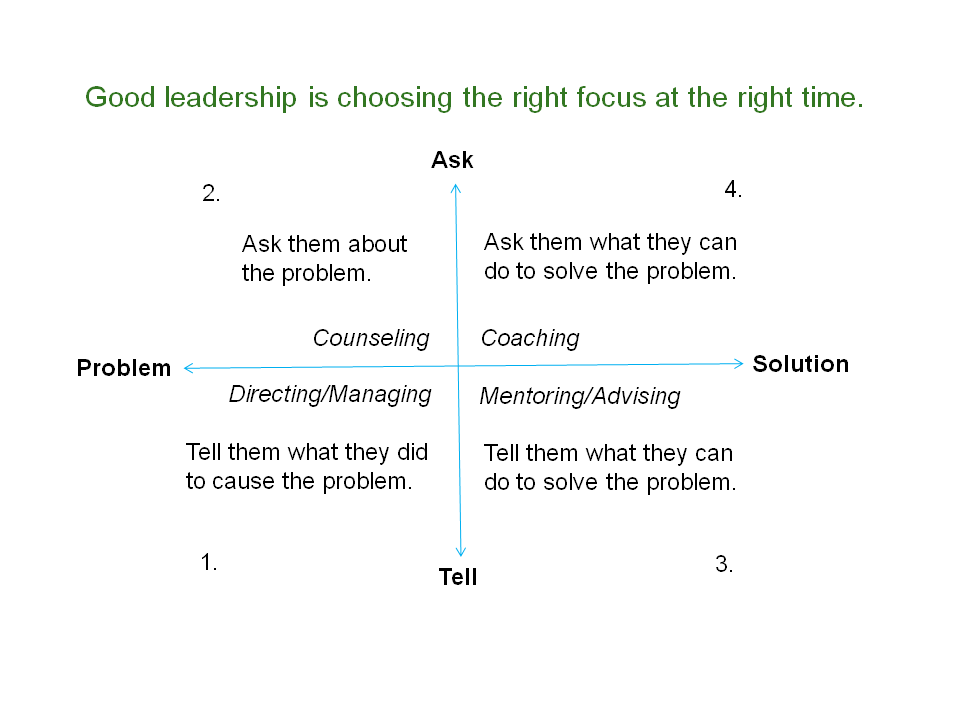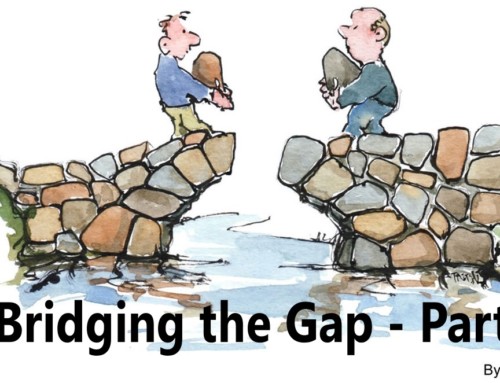Most business leaders are ignorant when it comes to coaching.
If you went around and asked a dozen leaders in your organization about the uses of coaching in the workplace you would get a dozen different answers.
Terms that would come up would include: executive coaching, team coaching, high-potential coaching, career coaching, and coaching to salvage poor performers. If you dive a little deeper and ask them how they use coaching on the job, it is likely they would say they coach their people often. They would say that they like to be available to their people, to share their expertise and show them or advise them on how they would handle the situation under discussion. That’s all well and good, but that’s NOT coaching!
The most common misunderstanding is confusing coaching with mentoring.
This confusion is natural. Most of us first experienced coaching as children growing up and playing sports. Sports coaches give us drills and have us work on fundamentals. They often step in and show us how to execute a particular skill, and then have us mimic their movements until we get it “right”. A sports coach is actually a sports mentor, someone who guides you, shows you, and advises you on how to perform activities according to the way they performed them or according to generally accepted best practices. Sharing expertise like that is a great thing, and something good leaders often do, but it is NOT coaching.
Creating a Coaching Culture in Your Organization
Whenever I start a program to instill a coaching culture into an organization, I ask the senior leaders to rate themselves on a simple 0-10 self-rating for these two items: How often do you choose coaching as your leadership style and how good are you at coaching?
Most leaders will rate themselves average or slightly above as a coach and say they use coaching as their leadership style 40% or 50% of the time.
As our program goes on, and they begin to learn what coaching really is, they have an epiphany and adjust this baseline self-evaluation down significantly.
The sad truth is, even senior leaders with 20+ years of successful leadership under their belt are woefully ignorant of what it means to coach as a leader, and are a complete novice at coaching their direct reports to high performance. Do you find that hard to believe? Let’s look at a simple quadrant chart that defines the primary difference between coaching and other primary leadership styles. As we discuss each quadrant, consider your own leadership style and see where you spend most of your leadership time. The quadrants are defined by the simple leadership focus choices you face when an employee brings you a dilemma: Do I ask or do I tell? And do I focus on the problem or on the solution?
Understanding the 4 Primary Leadership Style Choices
Let’s start in the most common leadership style quadrant: Directing or managing by telling people what they did to cause the problem. This is a natural response, well documented in many leadership and management books.
Ken Blanchard used a classic example in his best-selling management book, The One Minute Manager.
He asks to imagine your boss is standing at the end of a bowling alley and there is a curtain in front of the pins. You, the employee, roll your ball and you hear a crash of pins. The manager looks behind the sheet and then holds up two fingers, telling you how you did. Does that mean you knocked down 2 of the 10 pins? No, it means you missed 2!
This is the most common management approach for many reasons: our brains are uniquely wired to look for problems, our management training is focused on problems and “gap” analysis, and most of us were raised in environments where well meaning teachers, coaches and parents tried to keep us on the right path by pointing out when we went off course. This leadership style has its place, but it is grossly over-used, has severe limitations, and does little to develop the employee so that the same type of problem and poor performance is likely to recur.
A second, softer, approach is to ask about the problem.
This is the counseling approach. In business, it is often reserved for discussion around big issues, such as career guidance. Many people confuse this approach with coaching. Asking probing questions about the problem in the hope of getting the employee to examine all sides of their dilemma can be an effective approach at times, but is also limited in its effectiveness, as the new sciences of positive psychology and neuroscience so clearly show.
As leaders mature, their years of experience prepare them to become good at mentoring. This third leadership style is the one most senior leader’s confuse with coaching. It is a natural style for an experienced leader, since it is likely that any dilemma an employee brings them is likely to be one where they have “been there, done that.” Most employees value mentoring, since they get to benefit from the leaders sage advice to help them quickly solve their dilemma. Mentoring has an added hidden benefit for the employee: if the advice does not work, the responsibility for failure is shared with their manager who gave them the advice! Mentoring does have its place in your leadership repertoire, it is particularly useful if the employee has limited experience themselves with the dilemma they are bringing to you, or the problem is so urgent that you need to act with extreme speed to address the problem.
A Special Kind of On-The-Job Coaching that Solves Business’ Biggest Challenge Today
Finally we get to coaching, that most misunderstood of leadership styles.
Specifically, we are talking about coaching on-the-job and in-the-moment, a leadership skill that has come to be known as Performance Coaching. This leadership style was first documented for the business world by Sir John Whitmore in his classic text: Coaching for Performance.
Now in its fourth edition, it outlines a simple 4 step model for coaching that is focused on asking questions of your employee so that they can discover their own best solution. This approach has been further developed and refined by David Rock, who brings in some of the latest findings in neuroscience to explain why performance coaching is often superior to any other management style. For the senior leadership teams I have been privileged to work with, the results of adopting a performance coaching style are truly transformative. Here are some common testimonials to what adopting a performance coach approach has done for some very seasoned and already high-performing leaders:
“This (performance coaching) is the single most impactful leadership skill I have ever learned.”
“I wish I had learned this (performance coaching) 30 years ago.”
“Coaching is our future.”
An August 2011 strategy paper by Bersin and Associates named the managers’ inability to coach as the most severe performance management challenge facing business today. It’s no wonder, even the most experienced and enlightened leaders have only the slightest clue as to what it really means to coach. My next blog post will go into performance coaching more deeply, in the hopes that leaders can begin to understand, learn and adopt this most essential of leadership styles.







This is great Tom and such a needed area of focus. So many of us grew up with the “problem-focused” approach of “tell them what’s wrong and what to do” but, let’s face it, how many of us enjoy being told what’s wrong and what to do?!
Nonetheless, it’s very easy for this to become our default way of operating, (in either our professional or personal lives), especially in our high-demand, time pressured world- but the reality is that it doesn’t deliver effective or sustainable results.
Coaching is such a powerful and effective tool in unleasing, performance, creativity, and innovate solutions and so, as you point out, it’s really important to be clear on what coaching is and what it isn’t. Thanks for posting this and I’m looking forward to the next installment!
This is great Tom and such a needed area of focus. So many of us grew up with the “problem-focused” “tell them what’s wrong and what to do” approach, but, let’s face it, how many of us enjoy being told what’s wrong and what to do?!
Nonetheless, it’s very easy for this to become our default way of operating, (in either our professional or personal lives), especially in our high-demand, time pressured world- but the reality is that it doesn’t deliver effective or sustainable results.
Coaching is such a powerful and effective tool in unleashing performance, creativity, and innovative solutions and so, as you point out, it’s really important to be clear on what coaching is and what it isn’t. Thanks for posting this and I’m looking forward to the next installment!
Great article Tom! I totally agree with you on this one. I wonder though, is it ignorance or arrogance?
In my experience, adoption of coaching as a primary leadership style is 80-90% even with the most experienced leaders once the experience the benefits. A key is to get them over the coaching hurdle, which occurs when they practice the coach approach enough so that they experience their own aha moment when their coachee actually does come up with a better answer than they had thought of. The percentage of old dogs who won’t learn new tricks because they think they already know it all is thankfully quite small!